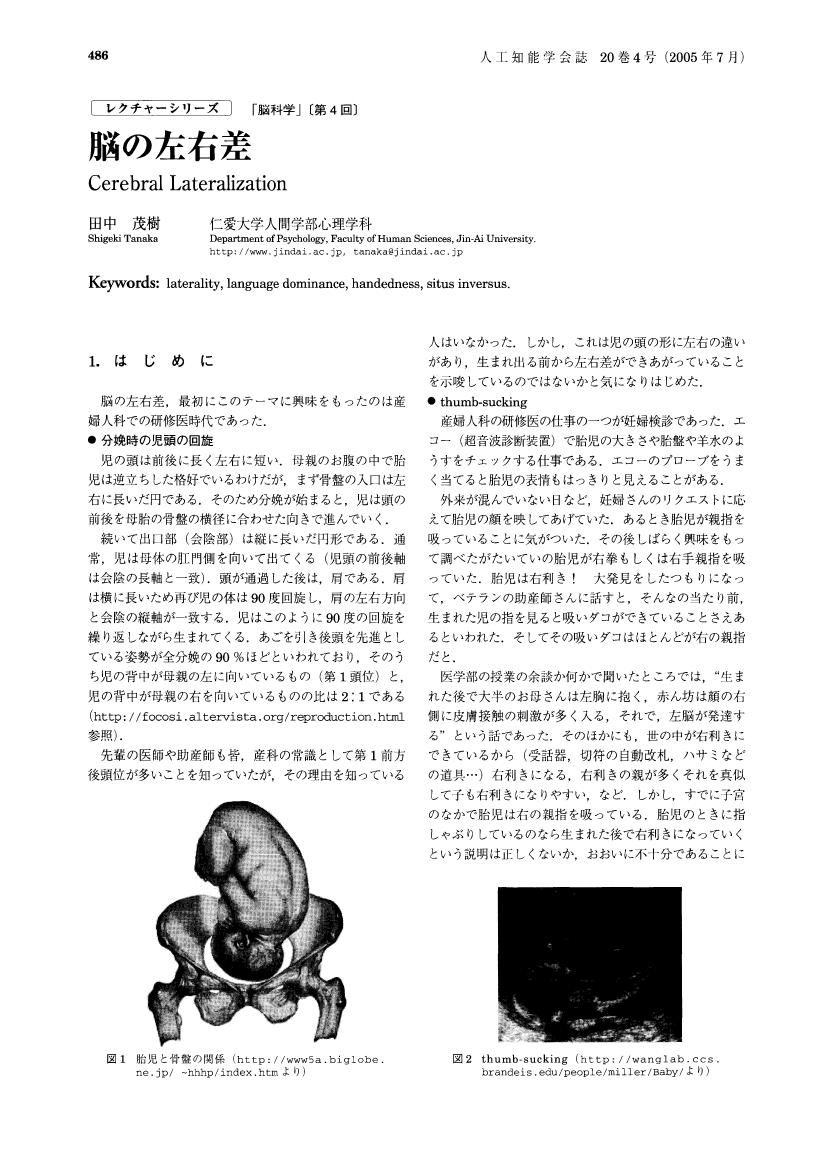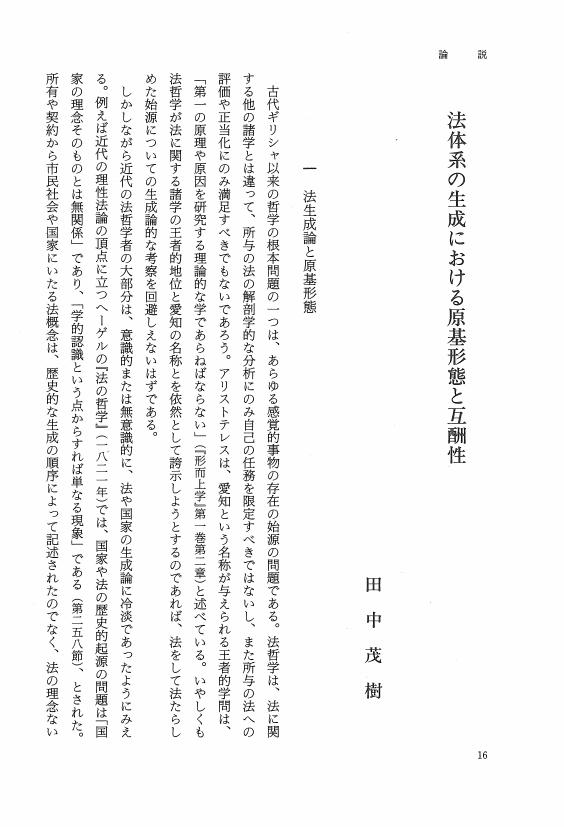2 0 0 0 OA 法における強制と合意 序論的一考察
- 著者
- 田中 茂樹
- 出版者
- 日本法哲学会
- 雑誌
- 法哲学年報 (ISSN:03872890)
- 巻号頁・発行日
- vol.1982, pp.16-36, 1983-10-10 (Released:2008-11-17)
- 参考文献数
- 54
1 0 0 0 OA 脳の左右差(<レクチャーシリーズ>「脳科学」〔第4回〕)
- 著者
- 田中 茂樹
- 出版者
- 一般社団法人 人工知能学会
- 雑誌
- 人工知能 (ISSN:21882266)
- 巻号頁・発行日
- vol.20, no.4, pp.486-491, 2005-07-01 (Released:2020-09-29)
1 0 0 0 OA 法体系の生成における原基形態と互酬性
- 著者
- 田中 茂樹
- 出版者
- 日本法哲学会
- 雑誌
- 法哲学年報 (ISSN:03872890)
- 巻号頁・発行日
- vol.1988, pp.16-29, 1989-10-30 (Released:2008-11-17)
- 参考文献数
- 5
1 0 0 0 OA 松下輝雄著『マルクス主義法理論の展開』
- 著者
- 田中 茂樹
- 出版者
- 日本法哲学会
- 雑誌
- 法哲学年報 (ISSN:03872890)
- 巻号頁・発行日
- vol.1981, pp.119-125, 1982-10-30 (Released:2008-11-17)
1 0 0 0 OA 加古祐二郎における存在論的弁証法と法システム
- 著者
- 田中 茂樹
- 出版者
- 日本法哲学会
- 雑誌
- 法哲学年報 (ISSN:03872890)
- 巻号頁・発行日
- vol.1978, pp.39-56, 1979-10-15 (Released:2008-11-17)
- 参考文献数
- 14
1 0 0 0 OA 難治性てんかん患者に対するlevetiracetamの長期効果
- 著者
- 松尾 光弘 藤井 明子 松坂 哲應 馬場 啓至 戸田 啓介 小野 智憲 田中 茂樹 里 龍晴 森内 浩幸
- 出版者
- 一般社団法人 日本小児神経学会
- 雑誌
- 脳と発達 (ISSN:00290831)
- 巻号頁・発行日
- vol.47, no.4, pp.272-278, 2015 (Released:2015-11-20)
- 参考文献数
- 24
【目的】難治性てんかんに対するlevetiracetam (LEV) 長期効果の判定. 【方法】観察期間は18カ月以上2年以内とした. LEVを追加投与した76症例に対し, 50%以上発作が減少した症例の割合 (以下50%RR) と有害事象を後方視的に検討した. 【結果】全症例の50%RRは42%であった. 局在関連てんかん54例と全般てんかん20例の50%RRは, 各々42%, 35%で, 著効例は局在関連てんかんに多かった. 有害事象として, 焦燥感, 多動・衝動性の亢進が目立ち, それらは自閉症または, 注意欠陥/多動性障害 (AD/HD) 傾向を合併した例に多かった. LEV追加投与前にγ-GTPが高値であった17例で追加時1剤以上を減量することで, 14例でγ-GTPの改善が認められた. 【結論】LEVは, 難治性てんかんの治療に有用であり, 長期にわたる効果が確認された. また, 肝臓への負担増悪因子となる可能性は低い. 一方, 自閉症またはAD/HD傾向を合併した患者へ投与の際には, 精神・行動面での変化を注意深く観察することが必要である.
1 0 0 0 <論文>日常言語学派における法的義務と当為
- 著者
- 田中 茂樹
- 出版者
- 関西学院大学
- 雑誌
- 法と政治 (ISSN:02880709)
- 巻号頁・発行日
- vol.33, no.3, pp.493-520, 1982-11-15
1. Preface 2. Being legally obliged and Legal Obligation 3. The Recognition of Legal Obligation 4. Obligation and Sanction or Coercion 5. The Binding Character of Obligatory Rule and Ought In this essay I shall examine a new theory on legal obligation, which is presented by Professor H. L. A. Hart and the Ordinary Language School. Japanese legal philosophy has received and criticized H. Kelsen's notion of Ought (Sollen). So Hart's attempt to reconstruct Kelsen's notion of Ought and Basic Norm (Grundnorm) is fresh and interesting. But Hart's notion of legal obligation is not so clear to elucidate the relation between coercive force and legal obligation in a legal system.
- 著者
- 斎藤 芳隆 飯嶋 一征 松坂 幸彦 松嶋 清穂 田中 茂樹 梶原 幸治 島津 繁之
- 出版者
- 宇宙航空研究開発機構
- 雑誌
- 宇宙航空研究開発機構研究開発報告 (ISSN:13491113)
- 巻号頁・発行日
- vol.11, pp.1-16, 2012-03
スーパープレッシャー気球とゼロプレッシャー気球からなるタンデム気球は高度を変えながら長時間飛翔する飛翔体である.このシステムにおいてはスーパープレッシャー気球に高い耐圧性能が要求される.20 μm 厚のポリエチレンフィルムに,ベクトランで作った菱目の網をかぶせた直径3 m のかぼちゃ型気球を製作し,地上で膨張,耐圧試験を実施したところ,正常に展開し,9,600 Pa に耐えることが実証された.これと同型の気球と2 kg のゴム気球からなるタンデム気球を,2011 年6 月1 日に大樹航空宇宙実験場より放球し,日昇をまたいだ飛翔性能試験を実施した.その結果,昼夜でスーパープレッシャー気球の皮膜温度は30 度変化すること,ゴム気球の夜間の浮力は地上での値と比較して5 % 減少することがわかった.これらの情報は,今後,スーパープレッシャー気球の要求耐圧を定量化するためや,同様のシステムを飛翔させる際のゴム気球の設定浮力を設定する際に極めて有用である.今後,大型のタンデム気球システムの開発を進めると共に,科学実験への応用を行なう予定である.
1 0 0 0 OA 難治性疼痛患者に対する仮想疼痛経験の検討
- 著者
- 池本 竜則 牛田 享宏 谷口 慎一郎 谷 俊一 森尾 一夫 佐々木 俊一 Zinchuk Vadim 田中 茂樹
- 出版者
- 日本疼痛学会
- 雑誌
- PAIN RESEARCH (ISSN:09158588)
- 巻号頁・発行日
- vol.19, no.3, pp.107-112, 2004-07-31 (Released:2014-02-20)
- 参考文献数
- 9
It is widely known that sensation of the pain is derived from sensory-discriminative factor and emotional factor. Especially in chronic pain, emotional factors and psychosocial backgrounds are more likely to contribute for the patients' discomfort. The aim of this study is to investigate how emotional factor of pain participates in intractable pain. We employed fMRI to compare the brain activations occurring in the orthopaedic neuropathic pain patients with allodynia and normal individuals in response to the visual virtual painful experience. During fMRI scanning, a video demonstrating an actual tactile stimulation of the palm and its imitation were shown to participants. In contrast to normal individuals,allodynia patients also displayed activation of the areas reflecting emotions: frontal lobe and anterior cingulate. These findings suggest that brain have important role in the development and maintaining of peripheral originated chronic painful condition.
1 0 0 0 OA 表在性疼痛と深部疼痛の脳内認知機構に関する研究 ─FMRI study ─
- 著者
- 池本 竜則 牛田 享宏 谷口 慎一郎 谷 俊一 森尾 一夫 佐々木 俊一 田中 茂樹
- 出版者
- 日本疼痛学会
- 雑誌
- PAIN RESEARCH (ISSN:09158588)
- 巻号頁・発行日
- vol.21, no.3, pp.117-125, 2006-08-20 (Released:2013-10-24)
- 参考文献数
- 36
- 被引用文献数
- 2 1
Using functional magnetic resonance imaging (FMRI) technology, we investigated the difference of pain related brain cortical activation derived from noxious stimulation to the skin and muscular tissue. Ten healthy volunteers who have no history of brain vascular disease were enrolled in this study. A cutaneouos pain was provoked by isotonic (0.9%) saline injection into intradermal space on right lower leg through 24G plastic catheter, and a muscle pain was provoked by hypertonic (3%) saline injection into right tibialis anterior muscle. We used event-related FMRI to measure brain activity during each injection. Visual analogue scale (VAS) was used to quantify pain intensity and unpleasantness, and pain quality was assessed with several verbal descriptions. Results: Pain unpleasantness rating was higher in the muscle pain compared to the cutaneous pain,despite the same pain intensity rating. The cutaneous pain had more acute pain onset than the muscle pain. Pain duration after stimulation was short in the cutaneous pain, but long in the muscle pain. The extent of the painful region tended to be larger with the muscle pain, but there was no statistical significance. Evoked FMRI response from the cutaneous pain showed distinct brain activation in the inferior and superior parietal cortex (BA: Brodmann area 5/7/40), primary and secondary somatosensory cortex (S1 & S2), insula, supplementary motor area (SMA, BA6), posterior cingulate cortex and cerebellum. On the other hand, FMRI response from muscle pain showed distinct brain activation mainly in the contralateral insula. These results suggest that the parietal lobe including the S1 is the essential area for cognition of sharp and well-localized pain conditions such as cutaneous pain, and may not be essential for cognition of diffuse pain derived from muscular tissue.
1 0 0 0 OA 痛みの改善に伴う脳活動の変化 ──fMRIによる検討──
- 著者
- 池本 竜則 牛田 享宏 谷口 慎一郎 谷 俊一 森尾 一夫 佐々木 俊一 田中 茂樹
- 出版者
- 日本疼痛学会
- 雑誌
- PAIN RESEARCH (ISSN:09158588)
- 巻号頁・発行日
- vol.20, no.3, pp.111-115, 2005-08-26 (Released:2014-01-16)
- 参考文献数
- 9
- 被引用文献数
- 1 3
We employed the functional MRI (fMRI) to investigate the changes of brain activation after reducing of capsaicin-induced heat hyperalgesia. Eight healthy volunteers who have no history of brain vascular disease were enrolled in this study. Capsaicin-induced heat hyperalgesia was developed by topical application of 2% capsaicin cream to anterior surface of left forearm. First fMRI time series were taken an hour after the application of capsaicin and second fMRI time series were taken an hour after medication (Loxoprofen Na: 120 mg). As for the pain task, 45°C wet cotton was put on the region where the heat hyperalgesia was evoked by capsaicin cream. Results of first fMRI time series showed distinct activation in the thalamus, anterior cingulate cortex, supplementary motor area, and prefrontal cortex. An hour after medication, though heat hyperalgesia still remained, all participants reported improvement of pain discomfort (VAS 4.7 to 2.5). Second series fMRI showed activation only in the thalamus. These results suggest that deactivated areas (anterior cingulate, etc.) observed after medication might be involved mainly in the pain related discomfort.
- 著者
- 富樫 誠 田中 茂樹 西 邦弘 吉岡 愛
- 出版者
- 一般社団法人日本建築学会
- 雑誌
- 日本建築学会近畿支部研究報告集. 計画系 (ISSN:13456652)
- 巻号頁・発行日
- no.36, pp.1037-1040, 1996-07-03
1 0 0 0 <認知科学な>日常(第3回)恥の重みとひきこもり
- 著者
- 田中 茂樹
- 出版者
- 岩波書店
- 雑誌
- 科学 (ISSN:00227625)
- 巻号頁・発行日
- vol.75, no.8, pp.915-918, 2005-08
1 0 0 0 8130 建築構造物の躯体工事費の概算手法に関する研究
- 著者
- 富樫 誠 西 邦弘 田中 茂樹 吉岡 愛
- 出版者
- 一般社団法人日本建築学会
- 雑誌
- 学術講演梗概集. F-1, 都市計画, 建築経済・住宅問題 (ISSN:13414534)
- 巻号頁・発行日
- vol.1996, pp.1209-1210, 1996-07-30





